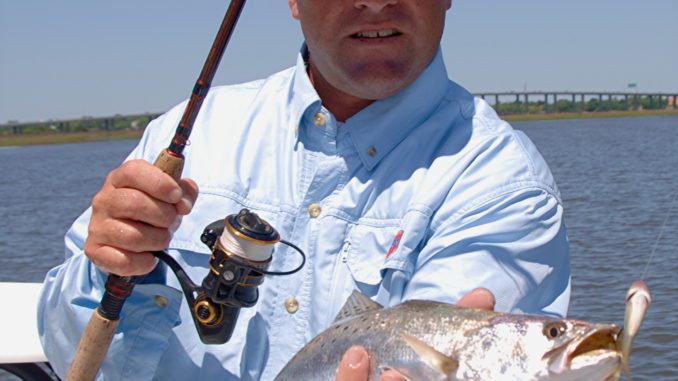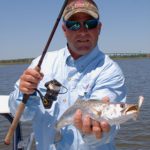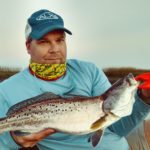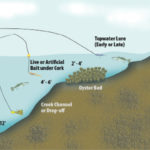
The big-girl trout are headed to the beach this month with spawning on their minds. Take a few of these tips and catch your share.
April showers may bring May flowers, but too much rain means muddy water, and South Carolina has had more than its muddy water over the past year. That’s just one reason that inshore fishermen in the Charleston area are dreaming of settled, stable weather on the horizon.
Guide Chris Chavis of Finstalker Charters said from the first of April until the middle of May, some of the biggest trout of the year will be looking for the best spawning grounds, and knowing what the fish are looking for is the first step in finding them.
“I can’t stress the clear water enough. That’s what everybody tries to find,” said Chavis. “Trout prefer clean, moving water, so if you combine the two, your success rate is going to be a lot better than just working any point or shell rake you see.”
Anglers may not be able to locate the numbers of fish that show up during the fall. Chavis said that’s because trout will spread out more to take advantage of suitable spawning grounds.
“Now that we’re getting to the spawning time of the year, you’ll start seeing more and more of those big females,” he said. “Most of the area guides now have gotten to the point that if we catch a big female and she’s full of roe, we try to let her go just to have more trout for the coming season.”
Chavis suggest anglers target both big females and the larger number of smaller males that will also be in residence by using a combination of live and artificial baits. He said it’s hard to beat shrimp — live or artificial. He will cast upstream of ambush points and drift or float his bait or lure downcurrent to the trout.
“We’re throwing both artificial and live bait,” he said. “Both of them seem to be working just as well as the other. The live bait scenario is throwing popping corks with a 2/0 live-bait hook. Using either mud minnows or shrimp — if it’s a shrimp, they’re going to eat it whether it’s a big shrimp or small. Artificial? It’s hard to beat a Gulp shrimp in natural colors.”
It might not seem unusual to note that fishing an area full of egg-laden females results in some “pregnancy cravings” from the ladies. For the most part, Chavis and other guides will stick with live bait because it is easier for clients to fish. The bait imparts the action even if that action is just being something to eat and drifting past an oyster rake.
Chavis admits that trout sometimes get finicky, in which case the artificial-bait game is on, and then it’s a matter of finding that color combination that satisfies that craving.
“I fish a lot of natural bait, but I also fish a lot of different colors for artificials, depending on what the day is holding,” he said. “A lot of times, you’ll fish natural for 4 or 5 days straight and go back another day and never get a bite. I end up switching to something crazy like a green or chartreuse artificial bait, and the next thing you know, they turn on.”
Chavis said that trout might be right up against the marsh grass, particularly the males who spend more time fertilizing eggs then females do laying them. On the other hand, females may be in the same vicinity but in slightly deeper water. To target both, he keeps several rods rigged and ready.
“Sometimes, the males will be up along the grass edge on the high end of the tide, particularly on a sunny day, but you get an overcast day, you’ll find those fish will go in a little deeper so tend to switch over,” he said. “Instead of casting a float rig, maybe switch over to a 1/4-ounce grub head where you can get your bait down a little deeper.”
Chavis chases the wind more than a specific location when fishing for trout, which means he burns more gas on a trout trip than a redfish trip. The key is finding clear, moving water in an ambush point like a sandbar or oyster rake where trout will hold in that water.
“The biggest factor is the wind direction and speed,” he said. “I’ll find areas along the lee edge of that wind, whether it be the Charleston Harbor itself or run up the Stono, Ashley, Cooper or Wando rivers. Sometimes, you’ve got to make runs to find that clean water.”
Chris Tweedy, who manages the fishing department at Palmetto State Armory in Mount Pleasant, looks forward to late April and May as bait returns to the creeks. He said like any style of fishing, matching your tactics to size, color and action of bait on which trout are feeding is a key.
Tweedy’s favorite time to catch speckled trout is from one hour before low tide through the first hour of the rising tide, especially if that cycle coincides with mid-day and a high, overhead sun.
“Trout are not too fond of bright sunlight, so when the tide pulls back away from cover, they don’t have much choice but to go deeper,” he said. “I look for troughs or holes that are 3 to 4 feet deeper than the water in the surrounding area. The best place to do this is the first 50 to 75 feet of a tributary that dumps into a major river like the Wando, Ashley, Cooper or Stono.”
Like Chavis, Tweedy said clear water is a key to finding trout read to feed. He said that even in a dirty creek, the dirtiest water will be the first couple of feet. Under that layer of faster-moving water will be water clear enough for trout to feed.
“I had great success during the flooding when everyone was complaining about muddy water,” said Tweedy. “Most people don’t realize the nasty stuff is washing across the top in the upper layer, and underneath is cleaner water with fish willing to bite.”
Tweedy said May specks will still be keying on small glass minnows and juvenile shrimp. He finds these baits hiding in the troughs, clinging to the bottom, especially where the current washes over a submerged oyster bar then drops off into the deeper water.
“I use a soft-plastic bait, something in a more natural color, and just bump it along the bottom,” said Tweedy. “I use a 1/6- or 1/10-ounce Z-Man Finesse Shroomz jighead and a Streakz or Paddlerz. That makes the plastic stand vertically on the bottom. A little bit of current will cause the tail to move, and the trout will usually bump it once, then come back and pick it up.”
When fishing at first light, Tweedy said May is the start of what he considers the best topwater fishing. He will target trout in the usual ambush spots: points, rakes, humps and breaklines. But instead of throwing a live bait suspended under a popping cork, he’ll throw a topwater bait like a Zara Spook Junior.
“I have noticed that trout prefer a particular cadence on different days,” said Tweedy. “For me, I will walk-the-dog, but it’s with three quick jerks, then keep the bait moving.”
He said his best topwater colors are natural with blue, black, silver, and gray.
DESTINATION INFORMATION
HOW TO GET THERE — Charleston is accessible from most areas of South Carolina via I-26 and US 17. Three popular boat ramps allow anglers to cover most of the waters around Charleston Harbor: Remley’s Point in Mount Pleasant close to the Cooper River bridge, Shem Creek in Mount Pleasant close to the ICW and Sullivan’s Island, and Wappoo Cut in West Ashley. For directions to these and other ramps, visit www.ccprc.com/64/Boat-Landings.
WHEN TO GO — Spring trout fishing kicks in around Charleston in April as fish enter an aggressive, prespawn mode. Good fishing will last until Memorial Day or until the weather turns into more of a summer situation.
BEST TECHNIQUES — Look for clear water, cover, current and warming water this month. Concentrate on tidal rips or seas where slack water and current meet. Drift a live shrimp, mud minnow or artificial bait under a popping cork through the area. On low tide, look for trout to hold in troughs or holes with water 3 to 4 feet deeper than surrounding areas. Cast a soft-plastic bait in natural colors on a stand-up jighead for best results.
FISHING INFO/GUIDES — Chris Chavis, Finstalker Charters, 843-509-9972, www.finstalker.net; Tom Siwarski, Carolina Aero Marine Adventures, 843-327-3434, www.carolinaaeromarine.com; Chris Tweedy, Palmetto State Armory, Mount Pleasant, 843-972-6136. See also Guides and Charters in Classifieds.
ACCOMMODATIONS — Best Western Patriots Point, Mount Pleasant, 843-971-7070; Town and Country Inn and Conference Center, Charleston, 800-334-6660; La Quinta Inn & Suites, Charleston, 843-556-5200; Charleston Convention and Visitors Bureau, www.charlestoncvb.com.
MAPS — Sealake Fishing Guides, 800-411-0185, www.thegoodspots.com.








Be the first to comment